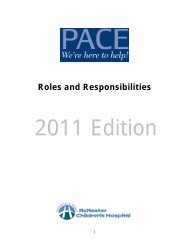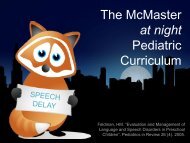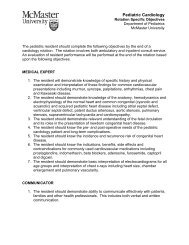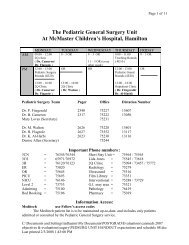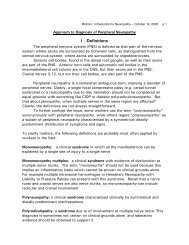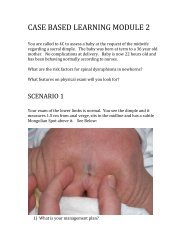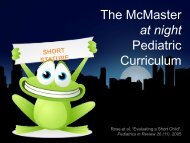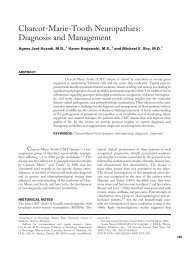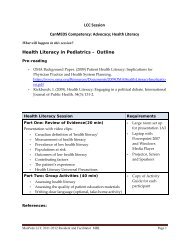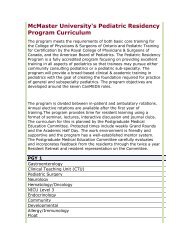CanMEDS Objectives - McMaster Pediatrics Residency Program
CanMEDS Objectives - McMaster Pediatrics Residency Program
CanMEDS Objectives - McMaster Pediatrics Residency Program
You also want an ePaper? Increase the reach of your titles
YUMPU automatically turns print PDFs into web optimized ePapers that Google loves.
Rotation Specific <strong>Objectives</strong><br />
Pediatric Surgery<br />
<strong>McMaster</strong> University<br />
Department of <strong>Pediatrics</strong><br />
Adapted from Canadian Association of Pediatric Surgeons (CAPS)<br />
I. Preamble<br />
A rotation in Pediatric Surgery should give residents the opportunity to become<br />
familiar with the peculiar needs of infants and children as surgical patients. Some of the<br />
surgical diseases encountered in children are similar in their presentation, management<br />
and outcome with their adult counterparts; others are quite different. The fundamental<br />
principles of surgical care, however, are similar to those that govern surgical practice in<br />
other age groups.<br />
MEDICAL EXPERT<br />
Knowledge: Basic Science and Anatomy<br />
1. The resident should have an awareness of human anatomy and normal<br />
physiology involving the chest, abdomen and inguinal region.<br />
Knowledge: General Clinical<br />
At the end of the rotation, the Pediatric resident should be able to:<br />
2. Demonstrate the unique communication skills necessary to obtain thorough,<br />
focused pediatric histories from children, parents or other caregivers;<br />
3. Elicit key physical signs in children despite potential poor compliance;<br />
Knowledge: Specific Clinical Problems<br />
At the end of the rotation, the Pediatric resident should be able to:<br />
4. Recognize the unique natural history of surgical diseases in children and use<br />
the information in reaching a diagnosis;<br />
5. Recognize the heat regulation problems in infants and the need for careful<br />
environmental control during evaluation and management;<br />
6. Recognize the limited host resistance and high risk of nosocomial infections<br />
in newborns, and the need for aseptic protocols to minimize environmental<br />
hazards;<br />
7. Recognize the need to individualize drug dosage and fluid administration on<br />
the basis of weight, and be able to calculate expediently fluid and electrolyte<br />
requirements using standard formulas;
Page 2 of 7<br />
8. Recognize and accommodate for the altered physiological systems (such as<br />
immature hepatic and renal function) that affect drug and anesthetic<br />
administration;<br />
9. Recognize the differences between types of sutures and choose the<br />
appropriate type and size for various wounds;<br />
10. Predict the risk of apnea post anesthesia and post narcotic administration in<br />
small infants;<br />
11. Appraise the place for nonoperative management of solid viscus injuries;<br />
12. Diagnose and apply principles of initial care and care during transport in the<br />
following neonatal conditions whose definitive management should only be<br />
undertaken in specialized pediatric facilities with qualified pediatric surgeons:<br />
congenital diaphragmatic hernia, esophageal atresia / tracheoesophageal<br />
fistula, gastroschisis / omphalocele, intestinal atresia, Hirschsprung's disease,<br />
imperforate anus, intestinal malrotation, major pulmonary parenchymal<br />
disease (congenital lobar emphysema, CCAM, etc.)<br />
13. Diagnose and refer the following problems that may be seen initially by a<br />
general surgeon but will almost always be best managed in a specialized<br />
pediatric facility:<br />
o congenital lesions of the lungs and mediastinum<br />
o gastroesophageal reflux (surgical management)<br />
o chest wall deformities (pectus excavatum and carinatum)<br />
o solid tumors of childhood (e.g. neuroblastoma, Wilms' tumor,<br />
hepatoblastoma)<br />
14. Diagnose and provide the initial management of several conditions which,<br />
while ideally managed in a special pediatric facility, may demand initial (and<br />
occasionally definitive) management locally because of urgency or distance:<br />
o incarcerated inguinal hernia in the neonate<br />
o aspirated and ingested foreign bodies<br />
o acute abdomen in the neonate or infant<br />
o acute gastrointestinal bleeding<br />
o blunt abdominal and thoracic trauma<br />
15. Diagnose, evaluate and optionally treat the following conditions which can be<br />
managed by experienced general surgeons or referred to a pediatric general<br />
surgeon (depending on prior experience and local resources). The<br />
pediatrician may be consulted and help in the diagnosis, management, and<br />
may recommend referral to a pediatric surgeon.:<br />
a) Head and Neck:<br />
acute & chronic lymphadenitis, thyroglossal duct cyst<br />
dermoid cyst, congenital torticollis,<br />
branchial cleft cyst and sinus,<br />
lymphangioma/hemolymphangioma, tongue tie<br />
b) Abdomen<br />
umbilical hernia, umbilical granuloma<br />
inguinal hernia, pyloric stenosis<br />
intussusception, Meckel's diverticulum, appendicitis
c) Scrotum<br />
communicating hydrocele, undescended testicle<br />
torsion of testis & appendix testis, epididymitis<br />
Page 3 of 7<br />
16. Formulate a clear plan for the evaluation of a child presenting with:<br />
o bilious vomiting<br />
o non-bilious vomiting<br />
o acute abdominal pain<br />
o chronic abdominal pain<br />
o constipation<br />
o rectal bleeding<br />
17. Predict common post-operative complications in children and initiate their<br />
treatment.<br />
18. Apply pediatric trauma principles in the initial resuscitation and management<br />
of traumatized children.<br />
Knowledge: Technical<br />
COMMUNICATOR<br />
1. Demonstrate aseptic technique in performing operative and bed-side<br />
procedures<br />
2. Recognize the appearance of normal & abnormal tissues in the operating<br />
room<br />
3. Gain proficiency in a variety of psychomotor skills (e.g. reduction of<br />
incarcerated inguinal hernia, wound closure, knot-tying, Percutaneous<br />
insertion of central lines etc.)<br />
4. Recognize the differences between types of sutures and know the type<br />
and size appropriate for various types of wounds<br />
Convey pertinent information from the history and physical examination in<br />
different circumstances (over the phone, in written form, during ward rounds and<br />
conferences).<br />
COLLABORATOR<br />
1. Be able to coordinate care involving many different team members, including<br />
anesthesia, intensive care, diagnostic imaging, nursing, and laboratory<br />
facilities<br />
2. Consults effectively with other physicians.
MANAGER<br />
Page 4 of 7<br />
1. Recognize that many surgical problems, although conceptually and<br />
technically within the realm of expertise of general surgeons, are more<br />
appropriately managed where there are special pediatric facilities (special<br />
pediatric expertise in anesthesia, intensive care, diagnostic imaging, nursing,<br />
and laboratory facilities);<br />
2. Is able to prioritize and manage multiple simultaneous clinical demands.<br />
HEALTH ADVOCATE<br />
1. The resident should be a trauma prevention and health improvement advocate<br />
2. The resident should recognize and respond appropriately.<br />
SCHOLAR<br />
Value the critical need of ongoing systems of peer review, maintenance of competence,<br />
and evaluation of outcomes in the surgical management of sick children.<br />
PROFESSIONAL<br />
1. Appreciate the peculiar emotional and ethical issues surrounding the care of a<br />
sick child and the need to involve parents, children's advocates and other health<br />
care-givers in many difficult situations;<br />
2. Be aware of the life-long significance of surgical management decisions in<br />
children and their impact on quality of life<br />
3. Appraise the ethics of research concerning children;<br />
4. Appreciate the sometimes complicated issues surrounding informed consent and<br />
refusal of treatment in children, especially in situations where “quality of life” is a<br />
major issue.
Page 5 of 7<br />
Neurosurgical Aims and <strong>Objectives</strong> for the Pediatric Residents<br />
Rotating through Pediatric Surgery<br />
Preamble<br />
The pediatric neurosurgical service is a two practitioner service providing a full range of<br />
neurosurgical care to infants and children. “Elective” cases are generally seen in<br />
consultation in the 3F clinic, and admitted following appropriate outpatient evaluation<br />
and preparation. Children who are in acute distress and potentially unstable are<br />
generally admitted either to the “step-down” unit or to the intensive care unit under the<br />
appropriate critical care pediatric specialist. Children in whom the diagnosis is unclear<br />
and require in-patient evaluation or observation for conditions, which may or may not<br />
require neurosurgical intervention are commonly admitted under the general pediatric<br />
service. In both those situations, the neurosurgical service remains very closely involved<br />
with their management in a consultative basis, maintaining frequent communication with<br />
the caregiving team on the ward, as well as with the patient and family. Thus the<br />
pediatric resident will have the opportunity to act in either a primary role or in a<br />
consultative role, depending on whether or not the neurosurgeon is the “most<br />
responsible physician”. In any case, since the “raison d’etre” of the rotation is education,<br />
the resident is encouraged to maintain close observation of all cases, even when not<br />
responsible for hands on care.<br />
Medical Expert/Clinical decision Maker<br />
Knowledge:Basic Science and Anatomy<br />
The resident should have an awareness of human anatomy and normal physiology<br />
involving the central nervous system.<br />
Knowledge:General clinical<br />
1. Recognizing that the pediatric resident will also have an opportunity to attend<br />
Neurosurgery clinics during their neurology/neurosurgery rotation, this rotation<br />
will afford an inpatient experience that will enhance their ability to recognize<br />
appropriate referral situations, and understand the care their own patients will<br />
receive when referral is required. By the completion of the rotation, the resident<br />
will be expected to:<br />
2. Be comfortable in using parental (guardian) history and personal observation in<br />
assessing alterations in mental status and levels of consciousness in infants and<br />
children<br />
3. Be able to initiate diagnostic and therapeutic interventions in children with<br />
suspected increased intracranial pressure<br />
4. Acquire a facility in the clinical skills of neurological assessment of infants and<br />
the use of the anterior fontanelle to assess intracranial pressure.
Page 6 of 7<br />
Knowledge:Specific Clinical Problems<br />
By the completion of the rotation, the resident will be expected to<br />
1. Have a basic understanding of the pathophysiology of active hydrocephalus<br />
and the shunting systems commonly used for its’ management<br />
2. Understand the pathophysiological basis for the treatment of acute head<br />
injuries<br />
3. Recognize the acute, subacute, and chronic complications of<br />
ventriculoperitoneal CSF diversion<br />
4. Recognize the common cranial deformities of infancy<br />
Specific learning objectives, beyond those demanded by the above “Aims” section, will<br />
be generated in response to the clinical material which presents during the rotation,<br />
supplemented by any specific goals negotiated between the resident and the pediatric<br />
neurosurgeon.<br />
Other CANMED goals (Communicator, Collaborator, Manager, Health Advocate,<br />
Scholar, Professional) are covered in this document under the general objectives.<br />
Clinical Resources<br />
Outpatient Clinics:<br />
General neurosurgery clinics: 3F – Tuesday and Thursday mornings<br />
Mrs. Carol Hirst clinical nurse specialist<br />
Neuroncology clinics: 3F34 – 1 st<br />
and 3 rd Tuesday afternoons<br />
Head injury followup clinics: 3F – 2 nd and 4 th Friday afternoons<br />
{variable; check with Dr. H.}<br />
Spina Bifida clinic:<br />
3F – 3 rd Friday afternoon<br />
Elective OR time: Wednesday 9:00 –15:00. [It is understood that the Wednesday<br />
afternoon teaching sessions are a priority; the pediatric resident is of course excused<br />
from the OR during those sessions, but is strongly encouraged to observe neurosurgical<br />
procedures when times do not conflict with the didactic sessions.]<br />
Miscellany<br />
Dr. Hollenberg’s office is room 4E8, telephone extension 75233, pager # 2385 (or<br />
through <strong>McMaster</strong> paging 75030). Dr. Hollenberg’s secretary is Mrs. Tanis Bunganich,
Page 7 of 7<br />
ext. 75235. Dr. Singh’s office is MDCL 5027 and Dr. Gunnarson’s office is 4E5. Their<br />
secretary is Ms. Fidelma DiFlorio and her extension is 75237.<br />
June 16, 2008





